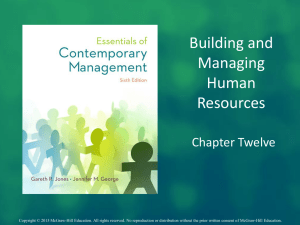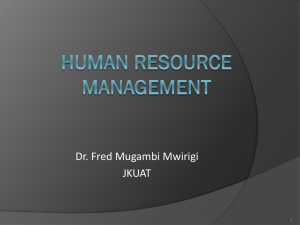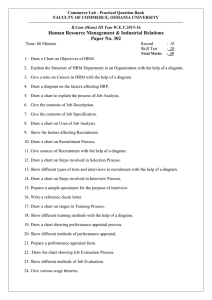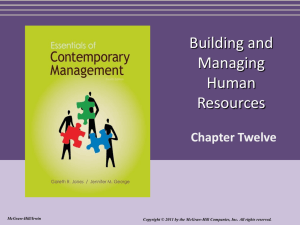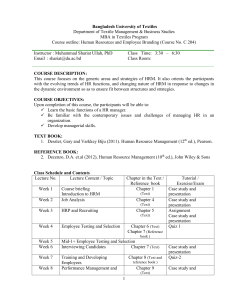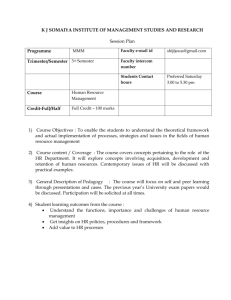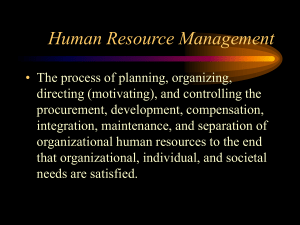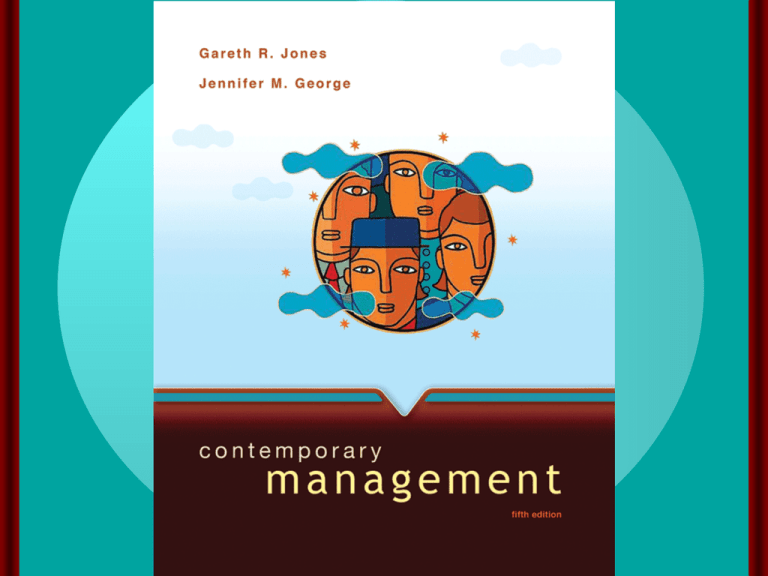
chapter twelve
Human Resource
Management
McGraw-Hill/Irwin
Contemporary Management, 5/e
Copyright © 2008 The McGraw-Hill Companies, Inc. All rights reserved.
Learning Objectives
• Explain why strategic human resource
management can help an organization gain a
competitive advantage.
• Describe the steps managers take to recruit
and select organizational members.
• Discuss the training and development options
that ensure organization members can
effectively perform their jobs.
12-3
Learning Objectives
• Explain why performance appraisal and
feedback is such a crucial activity, and
list the choices managers must make in
designing effective performance
appraisal and feedback procedures.
• Explain the issues managers face in
determining in determining levels of pay
and benefits
12-4
Strategic Human Resource
Management
• Human Resource Management (HRM)
–Activities that managers engage in to attract
and retain employees and to ensure that they
perform at a high
level and contribute
to the accomplishment
of organizational goals.
12-5
Strategic Human Resource
Management
• HRM activities
– Recruitment and selection
– Training and development
– Performance appraisal and feedback
– Pay and benefits
– Labor relations
12-6
Strategic Human Resource
Management
• Strategic Human Resource Management
– The process by which managers design the
components of a HRM system to be
consistent with each other, with other
elements of organizational architecture, and
with the organization’s strategy and goals.
12-7
Strategic Human Resource
Management
• “Six Sigma” quality improvement plans
– ensure that an organization’s products and
services are as free of errors or defects as
possible through a variety of human
resource-related initiatives
12-8
Components
of a Human
Resource
Management
System
Figure 12.1
12-9
HRM Components
• Recruitment and Selection
– Used to attract and hire new employees
who have the abilities, skills, and
experiences that will help an organization
achieve its goals.
12-10
HRM Components
• Training and Development
– Ensures that organizational members
develop the skills and abilities that will
enable them to perform their jobs effectively
in the present and the future
– Changes in technology and the environment
require that organizational members learn
new techniques and ways of working
12-11
HRM Components
• Performance Appraisal and Feedback
– Provides managers with the information
they need to make good human resources
decisions about how to train, motivate, and
reward organizational members
– Feedback from performance appraisal
serves a developmental purpose for
members of an organization
12-12
HRM Components
• Pay and Benefits
– Rewarding high performing organizational
members with raises, bonuses and
recognition.
• Increased pay provides additional
incentive.
• Benefits, such as health insurance,
reward membership in firm.
12-13
HRM Components
• Labor relations
– Steps that managers take to develop and
maintain good working relationships with the
labor unions that may represent their
employees’ interests
12-14
The Legal Environment of HRM
• Equal Employment Opportunity (EEO)
– The equal right of all citizens to the
opportunity to obtain employment
regardless of their gender, age, race,
country of origin, religion, or disabilities.
– Equal Employment Opportunity Commission
(EEOC) enforces employment laws.
12-15
The Legal Environment of HRM
• Contemporary challenges for managers
– How to eliminate sexual harassment
– How to make accommodations for
employees with disabilities
– How to deal with employees who have
substance abuse problems
– How to manage HIV-positive employees
and employees with AIDs
12-16
Recruitment and Selection
• Recruitment
– Activities that managers engage in to
develop a pool of candidates for open
positions.
12-17
Recruitment and Selection
• Selection
– The process that managers use to
determine the relative qualifications of job
applicants and their potential for performing
well in a particular job.
12-18
The Recruitment and Selection System
Figure 12.2
12-19
Human Resource Planning
• Human Resource Planning (HRP)
– Activities that managers engage in to
forecast their current and future needs for
human resources.
12-20
Human Resource Planning
• Demand forecasts
– Estimates the qualifications and numbers of
employees the firm will need given its goals
strategies.
• Supply forecasts
– Estimates the availability and qualifications
of current employees now and in the future,
as well as the supply of qualified workers in
the external labor market.
12-21
Human Resource Planning
• Outsourcing
– Using outside suppliers and manufacturers
to produce goods and services
– Using contract workers rather than hiring
them.
• More flexible for the firm.
• Provides human capital at a lower cost.
12-22
Human Resource Planning
• Problems with Outsourcing
– Loss of control over output; outsource
contractors are not committed to the firm.
– Unions are against outsourcing that has
potential to eliminate member’s jobs.
12-23
Job Analysis
• Job Analysis
– Identifying the tasks, duties and
responsibilities that make up a job and the
knowledge, skills, and abilities needed to
perform the job.
– Should be done for each job in the
organization.
12-24
Job Analysis
• Job analysis methods
– Observing what current workers do.
– Having workers and manages fill out
questionnaires.
12-25
Recruitment
• External Recruiting
– Looking outside the organization for people
who have not worked at the firm previously.
• Newspapers advertisements, open
houses, on-campus recruiting, employee
referrals, and through the Internet.
12-26
Recruitment
• Advantages of External Recruiting
– Having access to a potentially large
applicant pool
– Being able to attract people who have the
skills, knowledge, and abilities an
organization needs
– Bringing in newcomers who may have a
fresh approach to problems and be up to
date on the latest technology
12-27
Recruitment
• Disadvantages of External Recruiting
– Relatively high costs
– Candidates may lack knowledge about the
inner workings of the organization
– May need to receive more training
– Uncertainty concerning whether they will
actually be good performers
12-28
Recruitment
• Internal Recruiting
– Managers turn to existing employees to fill
open positions
– Benefits of internal recruiting:
• Internal applicants are already familiar
with the organization
• Managers already know candidates
• Can help boost levels of employee
motivation and morale
12-29
Honesty in Hiring
• Managers may be tempted to paint
overly rosy pictures of both the open
positions and the organization as a
whole
– Managers may feel that if they are honest,
an applicant may not be willing to work
there.
– Research indicates this is a poor strategy.
12-30
Honesty in Hiring
• Realistic Job Preview
– Providing an honest assessment of the
advantage and disadvantages of a job and
organization.
• Can reduce the number of new hires who
quit when their jobs and organizations fail
to meet their unrealistic expectations
12-31
Selection Tools
Figure 12.3
12-32
The Selection Process
• Selection
process
– Managers find out
whether each
applicant is
qualified for the
position and likely
to be a good
performer
12-33
The Selection Process
• Background Information
– Helpful to screen out applicants who are
lacking key qualifications
– Determine which qualified applicants are
more promising than others
12-34
The Selection Process
• Interviews
– Structured interviews where managers ask
each applicant the same job-related
questions.
– Unstructured interviews that resemble
normal conversations.
– Usually structured interviews preferred; bias
is possible in unstructured interviews.
12-35
The Selection Process
• Paper-and-Pencil Tests
– Ability tests assess the extent to which
applicants possess the skills necessary job
performance
– Managers must have sound evidence that
the tests are good predictors of
performance
12-36
The Selection Process
• Physical ability tests
– Measures of dexterity, strength, and
stamina for physically demanding jobs
– Measures must be job related to avoid
discrimination.
12-37
Selection Process
• Performance tests
– Tests that measure an applicant’s current
ability to perform the job or part of the job
such as requiring an applicant to take typing
speed test.
– Assessment centers are facilities where
managerial candidates are assessed on jobrelated activities over a period of a few
days.
12-38
Selection Process
• References
– Knowledgeable sources who know the
applicants’ skills, abilities, and other
personal characteristics
– Many former employers are reluctant to
provide negative information
12-39
Reliability and Validity
Selection tools must be reliable and valid.
– Reliability is the degree to which the
tool measures the same thing each time
it is used.
– Validity is the degree to which the test
measures what it is supposed to
measure
12-40
Training and Development
• Training
– Teaching organizational members how to
perform current jobs and helping them to
acquire the knowledge and skills they need
to be effective performers.
12-41
Training and Development
• Development
– Building the knowledge and skills of
organizational members to enable them to
take on new responsibilities and challenges.
12-42
Training and Development
• Needs Assessment
– An assessment of which employees need
training or development
and what type of skills
or knowledge they need
to acquire.
12-43
Training and Development
Figure 12.4
12-44
Types of Training
• Classroom Instruction
– Employees acquire skills in a classroom
setting.
• Includes use of videos, role-playing, and
simulations.
• On-the-Job Training
– Employee learning occurs in the work
setting as new worker does the job.
• Training is given by co-workers and can be done
continuously to update the skills of current
employees.
12-45
Types of Development
• Varied Work Experiences
– Top managers have need to and must build
expertise in many areas.
• Employees identified as possible top managers
are assigned different tasks and a variety of
positions in an organization.
• Formal Education
– Tuition reimbursement is common for
managers taking classes for MBA or jobrelated degrees.
• Long-distance learning can also be used to
reduce travel and other expenses for managerial
training.
12-46
Performance Appraisal and Feedback
• Performance Appraisal
– The evaluation of employees’ job
performance and contributions to their
organization.
• Performance Feedback
– The process through which managers share
performance appraisal information, give
subordinates an opportunity to reflect on
their own performance, and develop with
subordinates, plans for the future.
12-47
Types of Performance Appraisal
• Trait Appraisals
– Assessing subordinates on personal
characteristics that are relevant to job
performance.
– Disadvantages of trait appraisals
• Employees with a particular trait may choose not
to use that particular trait on the job.
• Traits and performance are not always obviously
linked
• It is difficult to give feedback on traits.
12-48
Performance Appraisal and Feedback
• Behavior Appraisals
– Assesses how workers perform their jobs—
the actual actions and behaviors that exhibit
on the job.
– Focuses on what a worker does right and
wrong and provides good feedback for
employees to change their behaviors.
• Results appraisals
– Managers appraise performance by the
results or the actual outcomes of work
behaviors
12-49
Performance Appraisal and Feedback
• Objective appraisals
– Assesses performance based on facts (e.g.,
sales figures).
• Subjective appraisals
– Assessments based on a manager’s
perceptions of traits, behavior, or results.
•
•
•
•
Graphic rating scales
Behaviorally anchored rating scales (BARS)
Behavior observation scales (BOS)
Forced ranking systems
12-50
Subject Measures of Performance:
Graphic Rating Scale
Figure 12.5
12-51
Subject Measures of Performance:
Behaviorally Anchored Rating Scale
Figure 12.5
12-52
Subject Measures of Performance:
Behavioral Observation Scale
Figure 12.5
12-53
Who Appraises Performance?
Figure 12.6
12-54
Who Appraises Performance?
• Self
– Self appraisals can supplement manager
view.
• Peer appraisal
– Coworkers provide appraisal; common in
team settings.
• 360 Degree
– A performance appraisal by peers,
subordinates, superiors, and clients who are
in a position to evaluate a manager’s
performance
12-55
Effective Performance Feedback
• Formal appraisals
– An appraisal conducted at a set time during
the year and based on performance
dimensions that were specified in advance
• Informal appraisals
– An unscheduled appraisal of ongoing
progress and areas for improvement
12-56
Effective Feedback Tips
• Be specific and focus on behaviors or
outcomes that are correctable and within
a worker’s ability to improve.
• Approach performance appraisal as an
exercise in problem solving and solution
finding, not criticizing.
• Express confidence in a subordinate
ability to improve.
• Provide performance feedback both
formally and informally.
12-57
Effective Feedback Tips
• Praise instances of high performance
and areas of a job in which a worker
excels.
• Avoid personal criticisms and treat
subordinates with respect.
• Agree to a timetable for performance
improvements.
12-58
Pay and Benefits
• Pay
– Includes employees’ base salaries, pay
raises, and bonuses
– Determined by characteristics of the
organization and the job and levels of
performance
– Benefits are based on membership in an
organization
12-59
Pay and Benefits
• Pay level
– The relative position of an organization’s
incentives in comparison with those of other
firms in the same industry employing similar
kinds of workers
• Managers can decide to offer low, average or
high relative wages.
• High wages attract and retain high performers
but raise costs; low wages can cause turnover
and lack of motivation but provide lower costs.
12-60
Pay and Benefits
• Pay Structure
– The arrangement of
jobs into categories
based on their
relative importance to
the organization and
its goals, level of
skills, and other
characteristics.
CEO
VP
VP
Director
Director
VP
Dept Manager
12-61
Pay and Benefits
• Benefits
– Legally required: social security, workers’
compensation
– Voluntary: health insurance, retirement, day
care
– Cafeteria-style benefits plans allow
employees to choose the best mix of
benefits for them; can be hard to manage.
12-62
Labor Relations
• Labor Relations
– The activities managers engage in to
ensure they have effective working
relationships with the labor unions that
represent their employees interests.
12-63
Labor Relations
• Laws regulating areas of employment.
– Fair Labor Standards Act (1938) prohibits
child labor, sets a minimum wage and
maximum working hours.
– Equal Pay Act (1963) men and women
doing equal work will get equal pay.
– Work Place Safety (1970) OSHA mandates
procedures for safe working conditions.
12-64
Unions
• Unions
– Represent worker’s interests to management in
organizations.
– The power that a manager has over an individual
worker causes workers to join together in unions to
try to prevent this.
12-65
Unions
• Collective bargaining
– Negotiation between labor and
management to resolve conflicts and
disputes about issues such as working
hours, wages, benefits, working conditions,
and job security.
12-66

